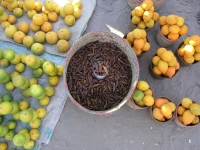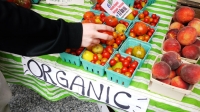News

03/06/2021
There are various elements connected to food safety and it can be challenging to group them together under the food safety umbrella. In fact, keeping up the pace with the contemporary reality can be challenging, and more and more areas related to food safety emerge: it could be challenging to recognize and trace the links.
In June 2021, the FAO Regional Office for Asia and the Pacific published a booklet entitled “Layman’s guide to food safety in Asia and the Pacific – Introduction to the food safety toolkit”. The booklet provides a small and unconventional handbook that introduces various food safety...
.jpg)
27/05/2021
Safe food is vital for the health of people, animals, economies – and our future. When food is safe, it contributes to food security, good health and wellbeing, reduces loss and waste and increases market access and decent work opportunities.
This will be the focus of the World Food Safety Day virtual event taking place on 7 June, which has as its theme: “Safe food now for a healthy tomorrow.” The online discussion, which is hosted by the Food and Agriculture Organization of the United Nations (FAO) and the World Health Organization (WHO) together with the Codex Alimentarius Secretariat, will start...

10/05/2021
Food allergies are a significant public health concern. With no cure, consumers must avoid the foods to which they are allergic by making informed food choices that include diligently reading food packaging labels and asking questions when making menu selections.
The list of 8 major foods and ingredients (cereals containing gluten, crustacea, egg, fish, peanut and soybeans, milk, tree nuts) known to cause...

05/05/2021
Indicators are a tool to demonstrate progress and results achieved in various topics and disciplines. Food security indicators and global nutrition index are good examples, and the Sustainable Development Goals (SDGs) have specific indicators to monitor progress. When it comes to food safety, it can be difficult to define quantifiable parameters that describe food safety, which instead is cross-cutting and often qualitative. Standardized sets of specific indicators may not be helpful to reflect the complex food safety situations in the different national contexts.
In April 2021, the FAO Regional Office for Asia and the Pacific published a booklet entitled “

29/04/2021
Having comparable levels of capacities across countries to ensure food safety can be a challenge. While implementing food safety measures reduces the toll foodborne diseases can take on human health, trade and productivity, interventions are less effective when the limited capacities of one country affect the more advanced capacities of another.
FAO established a series of multi-year projects, funded by the government of Japan, aimed at enhancing capacities to develop and implement international food safety standards in countries that are members of the Association of Southeast Asian Nations (ASEAN). The project led to results that have contributed to improving consumer health...

27/04/2021
Smallholder animal production has vital economic, practical and social value, and it is often linked with traditional and cultural practices. However, in addition to zoonotic risks, farming and slaughter practices may have a negative impact on food safety, the environment and biosecurity. Following simple measures can help ensure hygiene and safety.
In April 2021, the FAO Regional Office for Asia and the Pacific published a booklet entitled “Backyard farming and slaughtering – Keeping tradition safe”. This concise resource summarizes how the production of animal-derived food is linked to food safety and it outlines possible measures to mitigate the risks...

22/04/2021
Addressing antimicrobial resistance (AMR) can be a challenge from a legislative perspective: AMR is often defined as the quintessential food safety issue because it involves food, humans, animals and the environment. It would be time-consuming and confusing to create new legislation that addresses an issue covering so many different areas. Instead, legislation that already exists can be revised by looking at it through new lenses to help slow down the spread of AMR.
In April 2021, the FAO Regional Office for Asia and the Pacific published a booklet entitled “Slowing down superbugs – Legislation and antimicrobial resistance”. This concise resource outlines how existing legislation that is relevant to the problem can be adapted, rather than creating ad hoc legislation on...

09/04/2021
Edible insects can diversify diets, improve livelihoods, contribute to food and nutrition security and have a lower ecological footprint as compared to other sources of protein. These potential benefits combined with a heightened interest in exploring alternative sources of food that are both nutritious and environmentally sustainable are spurring commercial production of insects as food and animal feed.
While acknowledging the different opportunities that the sector might bring, this publication analyses the food safety implications associated with edible insects. Some key potential food safety hazards for edible insects are considered in this publication - biological (bacteria, virus, fungi, parasites), chemical (mycotoxins,...

02/04/2021
World Food Safety Day planning is underway. Initiatives will be held around the world and not just on 7 June. Last year events started in May and ran until August. FAO and the World Health Organization (WHO) are planning an online event for 7 June 2021 under the theme ‘Safe food now for a healthy tomorrow.’ Campaign messaging will continue to feature the slogan ‘Food safety is everyone’s business’.
Are you looking to take part? There are numerous ways in which you can do so. Whether you have time for a simple tweet or want to get more involved, UN Days...

31/03/2021
Organic food is often seen by consumers as healthy, tasty and environmentally friendly, but the organic food certification is not necessarily a synonym for safe food. Organic refers to a product that has been produced in accordance with certain standards throughout the production, handling, processing and marketing stages; it does not refer to the characteristics and properties of the finished product.
In fact, “organic” certification actually indicates the implementation of standards which aim at a different set of benefits: better incomes for small-scale farmers and increased food security, environmental benefits such as improved soil and water quality and biodiversity preservation, and...
Stay up to date and connect to our RSS feed!
